Thomas Hardy (2 page)

St Juliot and surrounding parishes.
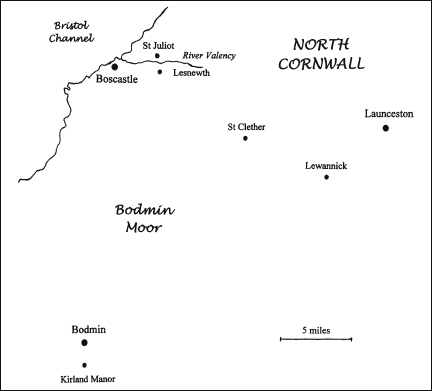
North Cornwall.
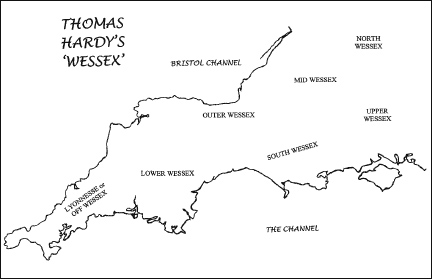
Thomas Hardy’s ‘Wessex’.
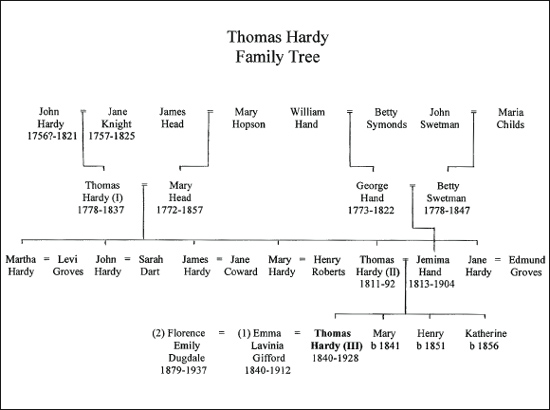
Hardy Family Tree.
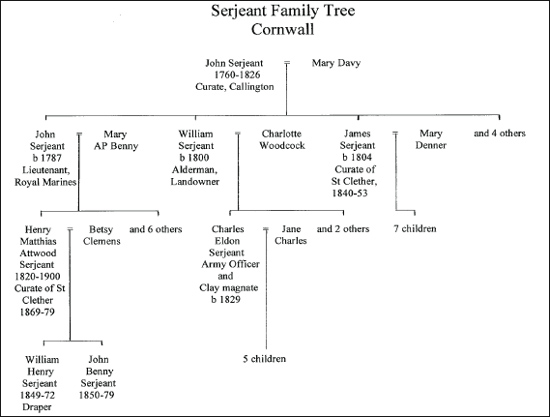
Thomas Hardy: Behind the Mask
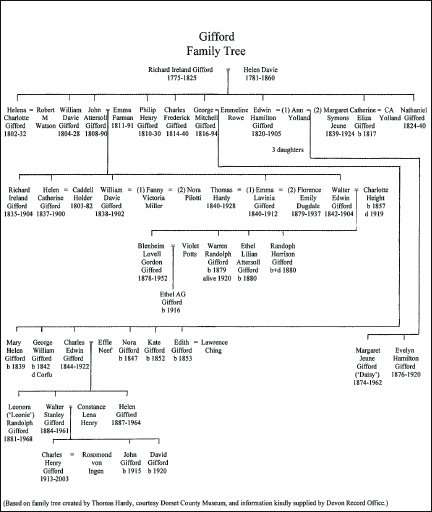
Gifford Family Tree.
Early Life: Influences
Birth: Forebears
Thomas Hardy – the third generation of his family to bear that name – was born in a remote house in the hamlet of Higher Bockhampton in rural Dorset, on 2 June 1840. His entry into the world was an inauspicious one, and his life almost ended even before it had properly begun, for the infant Thomas was ‘thrown aside as dead’. ‘Dead! Stop a minute,’cried the monthly nurse (who attended the women of the district during their confinement). ‘He’s alive enough, sure!’ and she managed to revive the lifeless infant. Shortly afterwards, when he was sleeping in his cradle, his mother discovered ‘a large snake curled up upon his breast’ – which was also asleep. Because of its size, it may be deduced that this was probably a harmless grass snake rather than a poisonous adder, which is smaller.
1
Thomas III, the subject of this book, was the firstborn of his family. The following year, 1841, his sister Mary arrived on the scene, but it would be another decade before brother Henry was born; to be followed by Katharine in 1856.
The Hardys firmly believed that they were descended from the more illustrious ‘le Hardy’ family of Jersey in the Channel Islands: John le Hardy having settled in Weymouth in the fifteenth century. They also believed that they were distantly related to Admiral Sir Thomas Masterman Hardy, who served under Horatio Nelson as flag captain of HMS
Victory
in the Battle of Trafalgar. (As yet, no documentary evidence has been produced to substantiate these claims.)
2
Thomas III’s family, on both sides, were hardworking and creative people, but their lives were not without incident. His paternal great-grandfather, John Hardy (born 1755), came from the village of Puddletown, 2 miles north-east of Higher Bockhampton, and 5 miles north-east of Dorchester. A mason, and later a master mason and employer of labour, John married Jane Knight and the couple had two sons: Thomas I (born 1778) and John.
Thomas I carried on the family tradition by adopting the same occupation as his father. At the age of 21, he ‘somewhat improvidently married’ a Mary Head from Berkshire; a person who had known great hardship as a child through being orphaned.
3
Thomas I and his wife Mary had six children, the oldest being Thomas II (born 1811). Under Thomas II the family business flourished with as many as fifteen men in its employ, including the ‘tranter’ who transported the materials to the building sites.
Hardy’s maternal grandmother, Elizabeth Swetman of Melbury Osmond – a hamlet in north-west Dorset situated on the boundary of Lord Ilchester’s estate – was descended from a family of landed yeomen. She was of a romantic disposition, had an excellent memory and could be relied upon by the parson to identify, in cases of doubt, any particular grave in the churchyard. Also, she was skilled in ministering to the sick of the locality; her authority being the English herbalist Nicholas Culpepper’s (1616–54)
Herbal and Dispensary
.
When Elizabeth met and secretly married a servant, one George Hand, so great was her father John’s disapproval of the match that he disinherited her. This was to have grave consequences; for soon after her father’s death, Elizabeth’s husband also died, whereupon she and her seven children were left destitute. One of these children, Jemima, born at No 1, Barton Close, Melbury Osmond, in 1813, was destined to become the mother of Thomas Hardy III.
Jemima was skilled at tambouring (embroidering) gloves and mantua (gown) making; she worked as a servant and cook in several Dorset houses, and also in London. In late 1836 she became cook to the Revd Edward Murray, vicar of Stinsford’s parish church of St Michael (Stinsford being a hamlet situated less than a mile from Higher Bockhampton). On 22 December 1839 Jemima married Thomas Hardy II at her mother’s family’s church of St Osmond, at Melbury Osmond.
When she married Thomas II, Jemima was already more than three months pregnant. In those days, however, conception before marriage was considered by the Dorset farm labourers (and even by the lower middle classes) to be nothing unusual. In fact, among such folk, a marriage did not normally proceed until the pregnancy had become obvious. There was a good reason for this: it was considered essential for a woman to prove her ability to bear children, who from an early age would be required to help support the family. In nineteenth-century Dorset, children as young as 8 years of age were commonly put to work in the fields.
4
Even today it might prove difficult to negotiate one’s way through the host of labyrinthine lanes to Hardy’s former house, were it not for the fact that the route is adequately signposted. The house lies on the boundary of woodland and heathland, and may therefore be approached either from the woods or from the heath, or alternatively from a lane known as Cherry Alley. In Hardy’s time, Cherry Alley contained seven other houses, each one occupied by a person of some standing in the community. These occupants included ‘two retired military officers, one old navy lieutenant, a small farmer [presumably it was his farm which was small, rather than he himself] and tranter, a relieving officer and registrar, and an old militiaman, whose wife was the monthly nurse that assisted Thomas Hardy III into the world’.
5
The Bockhampton house was a two-storey building with a thatched roof. It had been built in 1800–01 by Thomas III’s great-grandfather, John, for his son Thomas I and his wife Mary on land leased from the Kingston Maurward Estate. (In those days, a man with sufficient means could erect a dwelling for himself, or for a relative, and be thereafter permitted to live there for his lifetime; such a person being called a ‘livier’). Also included with the property were two gardens (one part orchard), a horse paddock, sand and gravel pits, and ‘like buildings’.
6
The entrance to the house was through a porch leading directly into the kitchen, which had a deeply recessed fireplace on its south wall. Adjacent to this was the parlour, and then a small office where the three generations of Hardys – who were stonemasons-cum-builders – did their accounts and kept their money. Their workmen were handed their wages through a tiny barred window which was little more than a foot square and situated at the rear. From the office, an open staircase led up to the first floor which had two bedrooms. These upstairs rooms, being built into the eaves, had sloping ceilings and it was in the main bedroom situated above the office, that Thomas III was born.
The house had a chimney at each end and was thatched with wheat straw. The walls were made of cob (a composition of clay and straw), with a brick-facing at the front. The ground floor was paved with Portland-stone flagstones; the first floor with floorboards of chestnut 7in wide. Candles were used for lighting, as was usual in those times.
At some later date a self-contained bedroom and kitchen were added, the materials used being of inferior quality to those used in the construction of the original dwelling. It is likely that this extension was built some time around 1837 in order to provide accommodation for Thomas III’s grandmother, Mary Hardy (
née
Head), who in that year had been left a widow. (This would explain why Mary appears in the 1851 census as living in the parish of Stinsford, of which Higher Bockhampton was a part.) Later still, perhaps after Mary’s own death in 1857, the two buildings were conjoined.
Adjacent to the Hardy house was Thorncombe Wood, where swallet holes are to be found, together with a natural water feature, Rushy Pond. The wood is bisected by the Roman road linking Dorchester (
Durnovaria
, 2 miles distant) with London (
Londinium
) via Badbury Rings and Salisbury (Old
Sarum
), and also by an iron fence dating from the Victorian era and marking the boundary between two estates. On the periphery of the wood, on the south side, lies the hazel coppice; this species of tree being specifically grown for hurdle-making. Beyond the wood, the River Frome meanders through a fertile valley, with the distant ridge of the Purbeck Hills in the background. Ten miles to the south lies the town of Weymouth. Behind the house there extends a huge area of heathland, which in Thomas III’s time was dotted with isolated cottages. This was subsequently given the name ‘Egdon Heath’ by Hardy.
This was the landscape which Thomas III came to know in intimate detail, and also to love. It imprinted itself indelibly on his mind, and through him it would one day become familiar to people in all parts of the world, even though the vast majority of them had never seen it at first hand. During his lifetime, Hardy would live for a period outside of Dorset, but his beloved home county would never be far from his thoughts.
One of Thomas III’s favourite occupations was to lie on his back in the sun, cover his face with his straw hat and think ‘how useless he was’. He decided, based on his ‘experiences of the world so far … [that] he did not wish to grow up … to be a man, or to possess things, but to remain as he was, in the same spot, and to know no more people than he already knew’ – which was about half a dozen.
7
In other words, he was perfectly happy and content.
